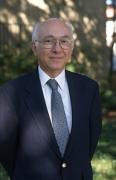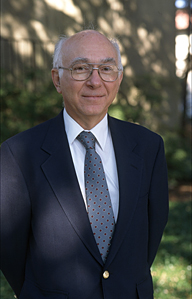2015 Peltier Award: Arlo U. Landolt
 The sky first attracted Arlo’s attention as a farm boy living on the prairies of southern Illinois. When it was too hot to sleep in the farmhouse, he would sleep on the hay frame wagon in the barnyard. Young Arlo would look up and watch the stars move across the sky as the night progressed. The different patterns, brightnesses and colors were a wondering spectacle!
The sky first attracted Arlo’s attention as a farm boy living on the prairies of southern Illinois. When it was too hot to sleep in the farmhouse, he would sleep on the hay frame wagon in the barnyard. Young Arlo would look up and watch the stars move across the sky as the night progressed. The different patterns, brightnesses and colors were a wondering spectacle!
This led to a professional life both as a university professor and as an observational astronomer specializing in astronomical photometry. The detectors have changed over time, from photographic photometry in the early days to photoelectric photometry to modern CCD photometry. Observing and being able to watch the sky through the open slit always has been a source of wonderment and joy. The smell of the night air, following the stars as they wended their way across the sky through the night and throughout the year has been shrouded in a kind of mysteriousness. This love of something defines the word “amateur”.
 The sky first attracted Arlo’s attention as a farm boy living on the prairies of southern Illinois. When it was too hot to sleep in the farmhouse, he would sleep on the hay frame wagon in the barnyard. Young Arlo would look up and watch the stars move across the sky as the night progressed. The different patterns, brightnesses and colors were a wondering spectacle!
The sky first attracted Arlo’s attention as a farm boy living on the prairies of southern Illinois. When it was too hot to sleep in the farmhouse, he would sleep on the hay frame wagon in the barnyard. Young Arlo would look up and watch the stars move across the sky as the night progressed. The different patterns, brightnesses and colors were a wondering spectacle!
This led to a professional life both as a university professor and as an observational astronomer specializing in astronomical photometry. The detectors have changed over time, from photographic photometry in the early days to photoelectric photometry to modern CCD photometry. Observing and being able to watch the sky through the open slit always has been a source of wonderment and joy. The smell of the night air, following the stars as they wended their way across the sky through the night and throughout the year has been shrouded in a kind of mysteriousness. This love of something defines the word “amateur”.
His observing has centered on standard star sequences, both distributed over the sky and for individual variable stars. These sequences in the Johnson UBV and Johnson-Kron-Cousins UBVRI photometric systems are of use to the entire astronomical observational communities, since the standard stars range in brightness between 7th and 22nd magnitude in V. The color range in the Johnson (B-V) is between -0.3 and +2.0, or so. These standards are adaptable to use with any detector in the amateur or professional community.
Over the years, Dr. Landolt has given dozens of lectures to groups at small institutions with no astronomers on staff. Many attendees were amateurs. These lectures allowed interaction with individuals interested in observational programs and techniques.
The reprints from many publications had finder charts which enabled unambiguous identification of his standard stars. The stars covered a range in brightness, so that there was a calibrating star for every need. Amateurs then could calibrate, and could transform their data, to a standard photometric system, thereby making more reliable the inter-comparison of their data with those of other observers. The sequences he established and published from his own data enable anyone to tie in their own measurements. The calibrated photometry of various variable stars which he has observed should be able to aid in establishing the zero point of variable star light curves where such effort is of value. In addition, these stellar standards provide value for photometry of asteroid, minor planets, satellites, comets and any astronomical object needing accurate calibration.



